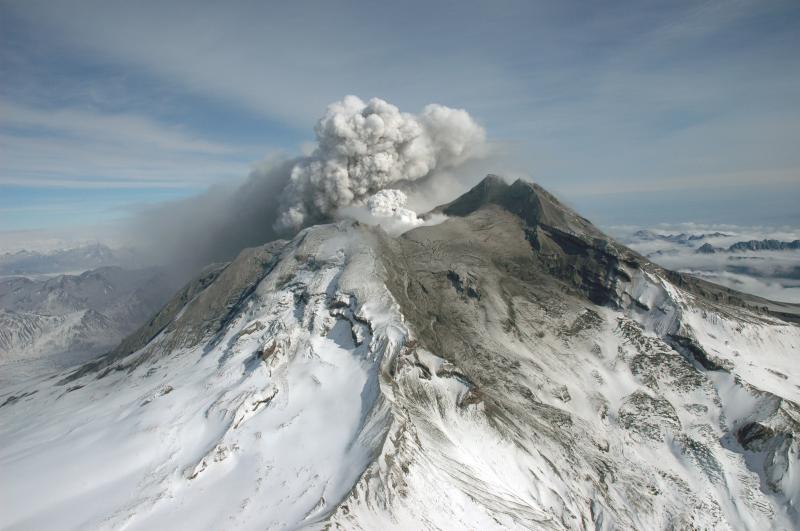Study of Redoubt and other volcanoes improves unrest detection
Volcanologists do what they can to provide the public enough warning about impending eruptions, but volcanoes are notoriously unpredictable. Alerts are sometimes given with little time for people to react.
That may soon change.
Work led by research assistant professor Társilo Girona, with the University of Alaska Fairbanks Geophysical Institute, has revealed a method by which scientists -- and the public -- can have perhaps years of advance warning about a potential eruption.
The solution lies in regular and widespread monitoring of the radiant temperature of a volcano's flanks before the appearance of any of the usual warning signs, such as glacier melting, sulfur odors, increased gas emissions, quaking and deformation.
Girona is the lead author of a paper published today in the journal Nature Geosciences titled "Large-Scale Thermal Unrest of Volcanoes for Years Prior To Eruption." The paper is co-authored by Vincent Realmuto and Paul Lundgren, research scientists at NASA's Jet Propulsion Laboratory in Pasadena, California. Lundgren supervises JPL's Earth Surface and Interior Group.
"This is showing that very large areas in the volcanoes are increasing the release of heat," Girona said. "It's a process which is going on in, we cannot say in the whole volcano itself, but in very large areas in the volcano. It's a large-scale process."
Girona also works with the Alaska Volcano Observatory, which is evaluating how best to integrate the research findings into its monitoring of Alaska volcanoes. The AVO is a cooperative organization among UAF, the U.S. Geological Survey and the Alaska Division of Geological and Geophysical Surveys.
David Fee, AVO coordinating scientist at UAF, said the findings can bolster volcano monitoring. That's important for the airline industry, particularly in Alaska and especially near Anchorage and other communities potentially in the path of an ash cloud.
"These results might provide critical information on how best to supplement existing monitoring networks, especially for difficult-to-monitor volcanoes in remote parts of Alaska," he said. "Any advance information on eruptions is helpful."
The research focused on five volcanoes that erupted or exploded in the past 20 years, that displayed a wide range of behaviors and characteristics, and that are considered representative of volcanoes worldwide: Mount Redoubt in Alaska, Mount Ontake in Japan, Mount Ruapehu in New Zealand, Calbuco in Chile and Pico do Fogo in Cabo Verde, an island nation off the west coast of Africa.
The researchers analyzed 16 ½ years of thermal infrared radiance data collected by NASA's Terra and Aqua satellites.
The satellite data had never been analyzed with an eye toward long-term early awareness of potential volcanic activity.
Girona, Realmuto and Lundgren wanted to answer this question: Does volcanic activity underground produce a noticeable increase in radiant temperature at the surface long before an eruption?
The data provided the answer for all five of the studied volcanoes: A clear "yes."
The researchers wrote that volcanoes can experience thermal unrest "for several years before eruption" and that the unrest "is dominated by a large-scale phenomenon operating over extensive areas of volcanic edifices." They also found that the heat increased regardless of the type of eruption.
Mount Redoubt, for example, had an increase of 0.85 degrees Fahrenheit, plus or minus 0.31 degrees (0.47 degrees Celsius, plus or minus 0.17), from mid-2006 to its major eruption of March 2009. Notably, the radiant temperature began increasing approximately one year earlier than the onset of other warning signs. Redoubt's radiant temperature began dropping quickly a year after the eruption and has remained low since 2014.
The researchers said their findings will allow scientists to anticipate eruptions that are difficult to forecast through other geophysical and geochemical methods.
"This is especially relevant for phreatic eruptions (volcanic gas explosions), such as the one at Ontake, Japan, in 2014," Girona said. "Phreatic eruptions are generally very difficult to anticipate with traditional methods."
The research, which Girona began at JPL and continued after moving to the Geophysical Institute, also provides insights into the interaction between a volcano's magmatic gases and its subsurface system of superheated water.
Lundgren said the new approach, combined with such tools as GPS or satellite radar measurements of surface displacements, can reveal even more about volcano processes.
For example, the team integrated surface heat emissions with surface displacements in another recent publication to better understand the behavior of Domuyo, a newly discovered deforming volcano in Argentina.

View east of Redoubt volcano and recent eruption deposits on the upper west-southwest flanks.
###
NOTE TO EDITORS:
Photographs of Mount Redoubt are available at https:/
Two graphics about Mount Redoubt are available at https:/
The research paper will be available at https:/
No comments:
Post a Comment